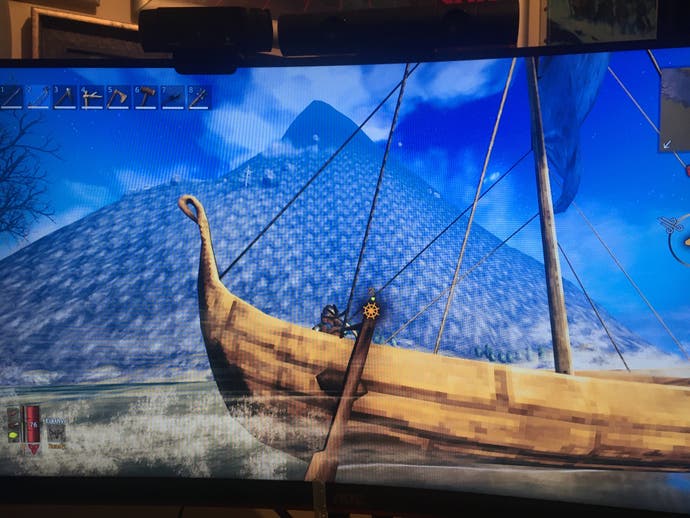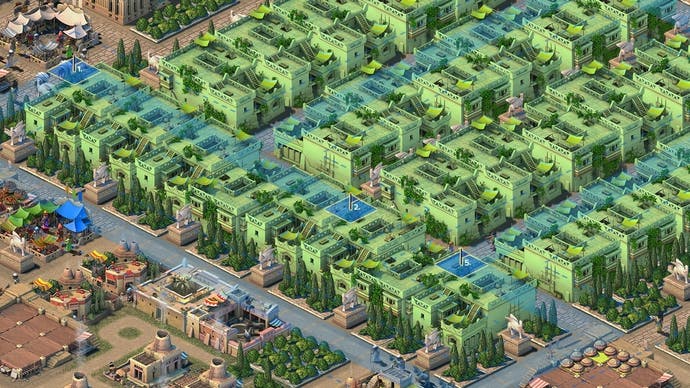What we've been playing
A few of the games that have us hooked at the moment.
26th of February, 2021
Hello! Welcome back to our regular feature where we write a little bit about some of the games we've found ourselves playing over the last few days. This time: plagues, vikings and ancient cities.
Nebuchadnezzar, PC
If you'd asked me a week ago to give you the whats and wheres and whens of ancient Mesopotamia, my history-deficient brain wouldn't have had much of a clue. Now, though, thanks to Nepos Games' engrossing old-school city builder, Nebuchadnezzar, I feel like I've an entire history lesson's worth of facts and figures with which to regale you.
That surprising bounty of actual historical context is just one of Nebuchadnezzar's lovely touches, niftily informing the structure and difficulty curve of its main campaign so your Mesopotamian city's rise from a couple of huts to a sprawling metropolis unfolds through the gradual introduction of chronologically correct new buildings and other mechanical complexities. You're essentially discovering new stuff at the same time your city's founders would have done in their own historical timeline.
In basic terms, though, Nebuchadnezzar's gameplay loops are familiar stuff - intentionally so, given it's openly inspired by the classic 90s city builders of developers like Impressions Games, albeit appropriately finessed for the modern era - charging players with juggling multiple production chains to ensure citizens are sufficiently numerous and adequately satisfied.
Ultimately, the goal is to ensure each production chain - irrigating parched land to grow crops to feed animals to make milk to turn into cheese to feed citizens and so on - is self-sustaining, so you can focus on the next closed loop of citizen classes with their own unique needs. And, more importantly, ensure you're producing enough surplus goods to trade, seeing as it's the only way to make the money for expansion in-game.
In fact, I'd say Nebuchadnezzar is more of a logistical puzzler than a city builder in a lot of ways (certainly, you won't need to worry about things like health or disaster or taxation here), requiring players to structure their slowly expanding metropolis so the likes of workshops and warehouses are all within reach of one another - a spatial challenge made more interesting by the immutable nature of the landscape. That's compounded by the fact commodities must be hand-delivered by sellers, each requiring carefully planned player-defined routes.
That latter aspect is part of a layer of micromanagement that perhaps won't be to everyone's tastes - although I love that I can interact so directly and meaningfully with certain citizens, admiring their beaming portraits when I do so. It gives a welcome level of intimacy missing in some of the more big-picture city builders.
Then there's the inherent repetition of each campaign mission, requiring players to cover the same old steps plus a bit more each time to reach their goal. For me though, that's part of the charm, and I've struggled to wrench myself free of Nebuchadnezzar's soothingly familiar cycles and logistical tinkering this week, happily losing hours to its gentle rhythm of expansion. A sandbox option is coming "soon", and I'll definitely be sticking around to play more.
Matt Wales
Valheim, PC

Like a lot of people out there right now, I've been spending many more hours in Valheim than is probably healthy. Most of that time has revolved around wholesome team based activities and I've been working with a handful of friends to slowly explore and conquer a couple of the central islands. We've built huge bases, perfected a streamlined mining and smelting operation, we've battled our way past three of the bosses and honestly, it's been wonderful. It's become our new 'hangout' game and it reminds me of the early days of PUBG where each excursion feels like a brand new story where we're in the central roles.
But then last night I decided to do something different. Last night I decided to go it alone. You see, somewhere online I'd stumbled across a screenshot of a fully uncovered Valheim map and right at the bottom, stretching out across the southern border were a network of strange red islands. And I just had to know what they were.
So, I loaded up a Karve with a few days worth of food, enough supplies to build a base and a teleporter and then I bid farewell to my friends and launched myself off, into the open ocean.
But it turns out solo sailing isn't as romantic as I'd imagined it. In fact, at times it was bloody hard work! I had to learn how to use tacking against strong winds as mosquitos from nearby Plains bore down on me. Sea monsters circled, roared and then chased me past neverending stretches of swampland. I passed a pair of gigantic living islands that rumbled and vibrated and then disappeared disconcertingly beneath the waves.
The further south I went, the more terrifying it became. The thought of losing my loot this far away from my base was a weight on my shoulders that grew heavier with each nautical mile passed. My friends are cool and everything, but I'm not sure they'd spend an hour of their lives sailing across half of the map just to help me get my armour back.
Then suddenly, through the mist, I saw an impossibly large mountain looming in the distance. I'd never seen anything quite like it in any of the biomes we'd already explored and once again my curiosity overcame my fear and I pushed on, ever southwards.
But what did I find when I finally reached the southern shores? Well, nothing much to be completely honest with you. It turns out that two of the fresh biomes I discovered, The cobweb covered Mistlands and the barren red islands of the Ashlands are actually still WIP. Due to the Early Access nature of the game, these parts of the world are just kind of placeholders at the moment. Nothing new spawns there and there are no unique resources to bring home as souvenirs.
So yes, after all that time and effort, the final destination was a little disappointing, but that didn't matter to me because I'd survived! I made it home safely through my teleporter with all my armour and loot intact and because of that, I'll always remember my first, epic journey into the unknown with great fondness.
Ian Higton
A Plague Tale: Innocence, PC, Xbox One, PS4

A Plague Tale passed me by in 2019, and maybe would have done so for good but for Game Pass, so now I'm rediscovering it, and I'm so glad I am.
What's immediately striking is how gorgeous it is. I really didn't expect it. But all of a sudden, there you are, in 14th Century rural France, in autumn, leaves reddening in the fairytale-like forests around you. And the detail this period of time has been recreated with! I think it shows that the developer, Asobo, is French, because there's a passion for a local history I don't think you would see from a non-native team. It's in the costumes, the buildings, the people: it's everywhere. I love the muddy churned tracks in the village, and the feeling of it being a functioning place. I imagine it's how it really did look.
On top of that, I admire the set-up that sees you as a girl who has to protect her younger brother, not through force, because how could she overpower an adult, but through sneaking. It's sensible, it's a different perspective, and I like that, and the performances from the two children, somewhat uncharacteristically for children-in-games, are very likable.
The other thing I love are the rats. This is a game about the plague, about the Black Death sweeping through Europe and France, on the back of hundreds of screeching black rats. And they're everywhere. They burst through walls like water through a crack in a dam, and they erupt from the earth like geysers. And anything the furious, furry blanket covers, it strips away like piranhas in a frenzy. And what a gruesome trail of destruction they leave, either directly or indirectly as people take preventative measures to halt them, like slaughtering all the livestock in the area, resulting in piles of putrefying carcasses, great pools of blood and mud, and everywhere the buzzing with flies. And through all of this - and more threats beside - the two children walk.
It's a pretty relentless ride. I could do with one or two more breathers along the way, here and there. But what an opening. What a powerful, provocative, and intriguing start. And what of the real darkness underneath? I can't wait to play more.
Bertie










